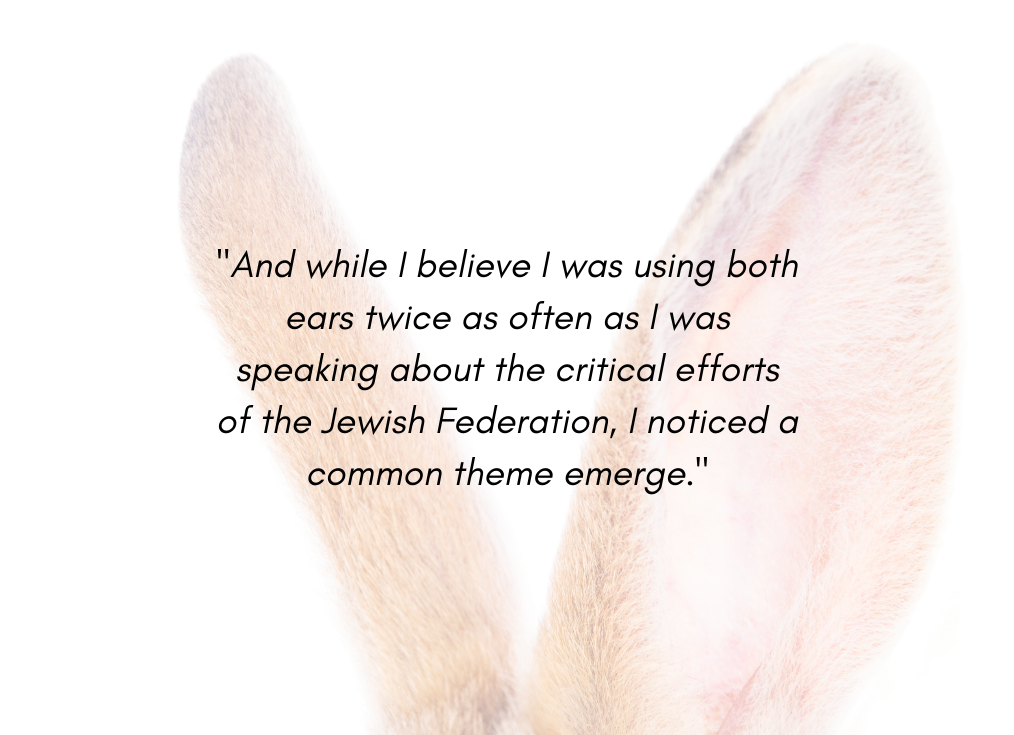Two Ears and One Mouth

July 30, 2021
I begin this week’s column with a confession, or maybe it’s an apology, or maybe it’s both?
I did not address a critical item in last week’s Torah portion Va’etchanan because I wanted to raise it as part of this week’s Eikev parashah… the Shema prayer.
The Shema often referred to as the Jewish people’s core prayer, ‘the centerpiece of the daily morning and evening prayer services… is considered by some the most essential prayer in all of Judaism.’ However, my caveat to this noble designation is that most Jews only know the initial verse of the whole Shema prayer found in last week’s reading, “Hear oh Israel, Lrd our Gd, the Lrd is One.” (Deut. 6:4)
In fact, there are three parts to the entire Shema prayer, last week’s first paragraph (Deuteronomy 6:4-9), this week’s second paragraph (Deuteronomy 11:13-21), and the third paragraph that was read in parahsha Shelach (Numbers 15:37-41) a few months ago.
So, why wait until this week? I am so glad you asked. A few years ago, Rabbi Lord Jonathan Sacks z”l, wrote a dvar Torah about this week’s parashah that I took to heart back then and that the essence of which has stayed with me since. Although Rabbi Sacks goes into wonderful depths on the lessons to be learned through our Jewish tradition, what stuck with me was something much more basic, and to a school principal, it was significantly more elementary. In fact, the concept is so much more foundational it was coined almost two millennia ago by Epictetus, “We have two ears and one mouth so that we listen twice as often as we speak.”
Over the last year-plus, since joining the Jewish Federation of San Antonio’s professional staff, I feel like I have been on a listening tour. Although much of my time has been virtual and during the challenges of a global pandemic, I still had the opportunity and pleasure of meeting hundreds of members of our Jewish San Antonio community. And while I believe I was using both ears twice as often as I was speaking about the critical efforts of the Jewish Federation, I noticed a common theme emerge. Those community members who supported Federation’s mission, and who actively participated in the Jewish Federation’s efforts, understood their role in a very different way than those who were more critical of Federation’s purpose.
To simplify my observations, I boiled the relationships down to one distinct difference. Those who supported the Annual Campaign not only in generosity but also in concept saw their gift as an “investment” in the Jewish community. While those who participated with reluctance (or not at all) saw their relationship as transactional and as a “donation” with no reciprocity.
Now, this was not universal, and not every person I spoke to fell ever so perfectly into one of these two categories, however, the themes arose so often that I believe this is definitely something to be considered in greater depth, and consequently from which we at the Jewish Federation can learn and grow. But this idea is not concluded here. Next week I will share a metaphor that I believe encapsulates these relationships even more clearly.
In the meantime, I encourage you to reflect on what Jewish community means to you. Is it the community of your nuclear family? Is it your synagogue, temple, JCC, youth group, and/or social community? Is community peoplehood, nationhood, or simply a neighborhood?
At the Jewish Federation we ask these questions every day, and although some days the answer seems clearer than others, what we know for sure is that without your support, participation, and dedication the Jewish Federation would not be…
Shabbat shalom,

